Malaria kills a child every minute worldwide; will a new vaccine save them?
Some Key Facts about Malaria
Globally in 2022, there were an estimated 249 million malaria cases and 608,000 malaria deaths in 85 countries.
Africa has the highest share with 94% of malaria cases (233 million) and 95% (580,000) of malaria deaths.
Children under 5 years old accounted for about 80% of all malaria deaths in the Region.[1]
However Adar Poonawalla, CEO of India-based drugs manufacturer The Serum Institute, has said that the roll-out of the new affordable malaria vaccine R21, combined with breakthroughs in the genetic modification of mosquitoes means that a world free of malaria is "finally within sight."
Malaria remains prevalent in subtropical and tropical parts of the world
Malaria is caused by a parasite carried by some types of mosquito and is prevalent in subtropical and tropical climates. Although the vast majority of people infected with malaria recover, the disease can be deadly, especially among small children with 80% of victims under 5 years old.
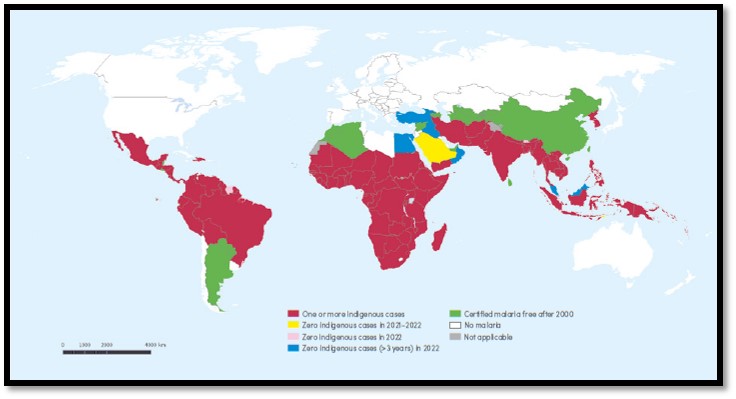
WHO World Malaria Report: Red indicates malaria, green are malaria free after year 2000, white no malaria
Malaria spreads through the bite of female mosquitoes
We know that malaria is transmitted through mosquitoes, more specifically, the disease is transmitted via a bite from a female Anopheles mosquito that is infected with Plasmodium parasites. There are five different species of the Plasmodium parasite that can transmit malaria from female mosquitoes to humans.
When the Anopheles mosquito that carries the malaria parasite bites a person, it sends the parasite through the bloodstream, where it shapeshifts through stages of its life cycle. The complexity of the malaria parasite's life cycle has meant vaccine development has been hampered for years. The new R21 malaria vaccine targets the first stage of the parasite's life cycle when the first form of the malaria parasite enters the human body[2] before it gets to the liver and is combined with an immune-boosting agent, or adjuvant, made by the US company Novavax.[3]
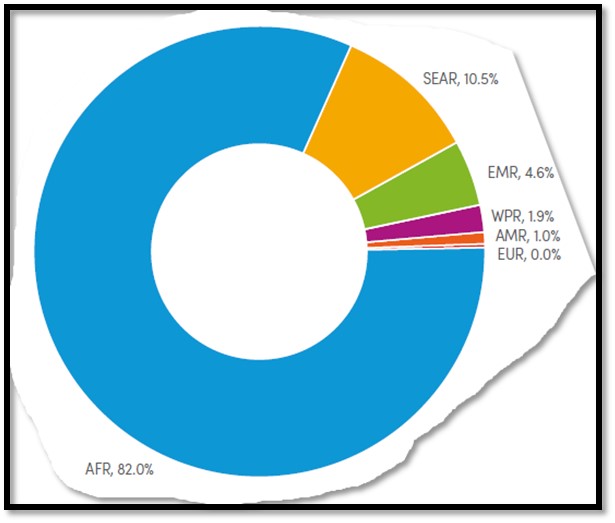
WHO World Malaria Report: Distribution of malaria cases in 2000-2022 by region
AFR=Africa, SEAR=South-East Asia, EMR=Eastern Mediterranean, WPR=Western Pacific, AMR=Americas, EUR=Europe
Why do mosquitoes bite us?
We know only the females bite humans. They don’t do it for self-defence like bees. It’s also not their only source of food since both males and females drink nectar from flowers. What the females need are the proteins found in animal blood in order to develop eggs, and humans, being animals, also count among their prey.
When a female lands on your skin it looks for a capillary under the skin using its palps, the sensory appendages on the front of the head. Once on top of the capillary, it uses a trumpet-shaped organ called the proboscis, an appendage which is more or less equivalent to a mouth. The proboscis is made up a number of different organs, and inside it are the stilettos. These are used to pierce the skin until the blood vessel is found. Once found, the mosquito begins to drink blood using a different part of the proboscis only used to suck blood, the labrum.
While the mosquito sucks blood, it simultaneously injects its saliva into the area using a different tube, the hypopharynx. The saliva contains anti-coagulant proteins, allowing a continuous flow of blood and stopping the closing of the pierced area. This way, the mosquitos can drink blood quickly without us noticing.
Malaria symptoms can vary
Malaria patients can experience a range of symptoms — from none to mild, to severe. Typically symptoms include tiredness, flu and fever-like illness, chills, muscle aches and headaches. Severe cases of malaria can cause organ failure and even death. But malaria is curable if diagnosed quickly and treated correctly.
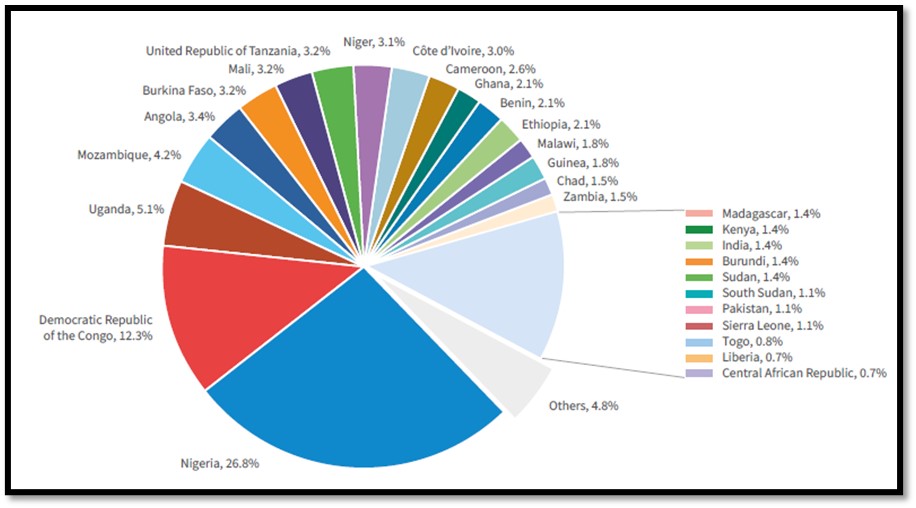
WHO World Malaria Report: Distribution of malaria cases in Africa in 2022 by country
Progress has been made in the past in reducing infections and death
Despite the lack of a malaria vaccine, between 2000 and 2015 much significant progress was made in reducing infections and deaths through vector control and antimalarials and it prompted talk of moving beyond the aim of elimination towards malaria eradication. However, since 2015 progress has been backsliding and this was deeply worsened by the COVID-19 pandemic. Now, the hope is that using vaccines alongside other approaches to reduce infection will be a game-changer.[4]
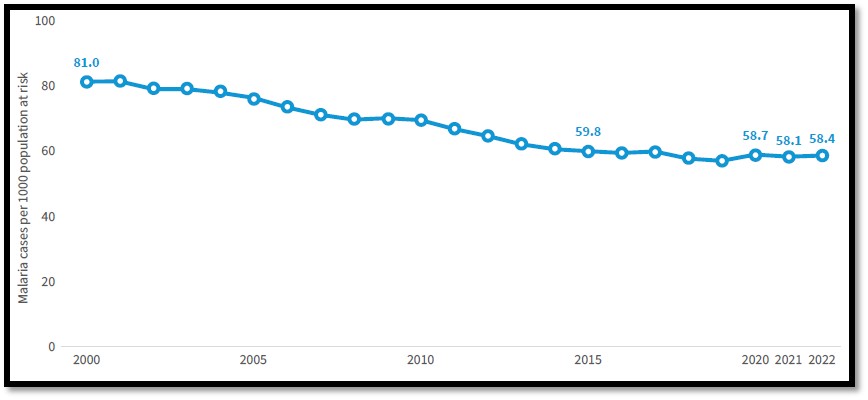
WHO World Malaria Report: Global trends, cases per 1,000 population at risk
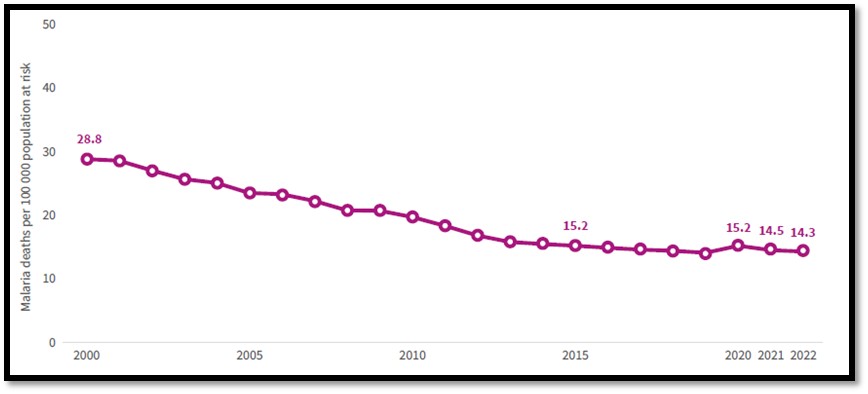
WHO World Malaria Report: Global trends, deaths per 100,000 population at risk
Results from the ongoing phase 3 trial of 4,800 children across Burkina Faso, Kenya, Mali and Tanzania have been published. The Times reported that trials have shown it to be 79% effective at preventing the disease in young people and its production capacity and low price give it a "huge advantage" over the only other malaria vaccine, RTS, which was released earlier. At around $4 (£3.10) a dose, R21 is less than half the cost of its rival and the Serum Institute, which manufactures the vaccine, claims it could produce 100 million doses a year.[5]
The WHO does recommend it and Gavi and UNICEF have begun funding and procuring vaccine doses to protect children across Africa. The roll-out of R21 malaria vaccine began in Ivory Coast on 15 July 2024 and in South Sudan and is targeted at children under three years old.[6] Then the program will expand to a further 15 countries in Africa, including the Central African Republic, Democratic Republic of Congo, Ghana, Mozambique, Uganda and Nigeria, by the end of the year, with another 15 African nations due to follow.
Adar Poonawalla said, "Cost is absolutely the key question. If this was a $10 vaccine, just forget it, you wouldn't be able to reach the kind of countries we have because the budgets just wouldn't allow it. We've spent so many years – blood, sweat and money – developing this with Oxford. After all this effort and going through the regulatory process, we're finally here. This is a great moment."
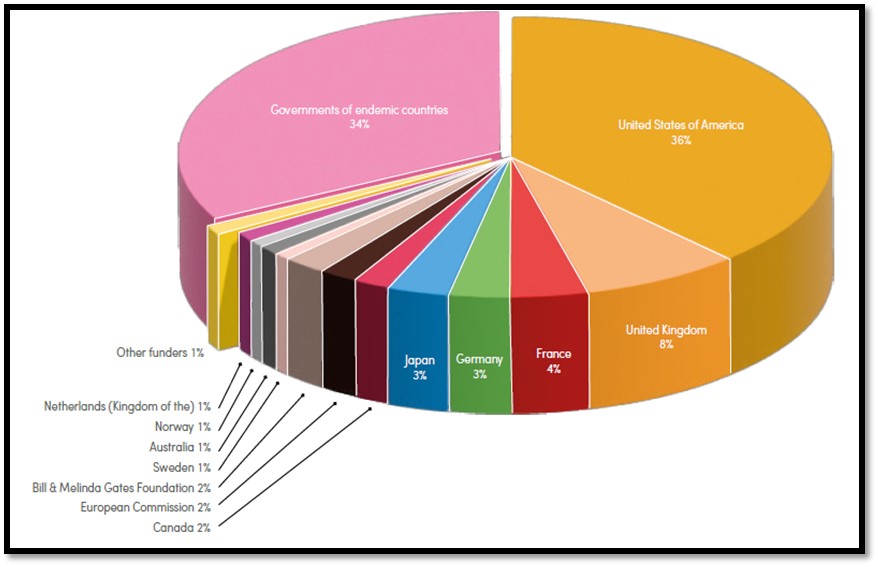
WHO World Malaria Report: Funding for malaria control and elimination 2010-2022
Where is China in the fight against malaria? Part of the 1% of “other funders.”
There are two malaria vaccines for children
The World Health Organization has now recommended two vaccines to prevent malaria in children, RTS and R21. The world’s first routine immunization program using RTS began in Cameroon in January 2024. More countries in Africa have also started rolling out RTS as part of routine immunization programs. R21 is expected to be rolled out in several African countries starting from May 2024. Demand for these vaccines is high; at least 28 countries in Africa have expressed interest.[7]
Ghana has become the first country in the world to approve the highly anticipated R21 malaria vaccine that could save millions from the mosquito-borne disease. The R21 malaria vaccine, developed by the University of Oxford and manufactured and scaled up by the Serum Institute of India is only the second vaccine the world has seen for a disease that has caused untold suffering for millennia.[8]
Ghana's Food and Drugs Authority has assessed the trial data and approved the R21/RTS malaria vaccines for use in children aged 5 to 36 months who are at highest risk of death from malaria.
This new vaccine comes hot on the heels of the RTS vaccine which was approved in October 2021 by the World Health Organization. Four doses of RTS vaccine reduce clinical malaria cases by 39% and severe malaria by 30%.
The development of these vaccines is historic and when used in conjunction with other preventative measures such as mosquito nets there is the potential to reduce the risk of death from malaria among children. Though not a silver bullet in the fight against malaria, they are a welcome tool to fight this preventable disease and end the global health crisis.
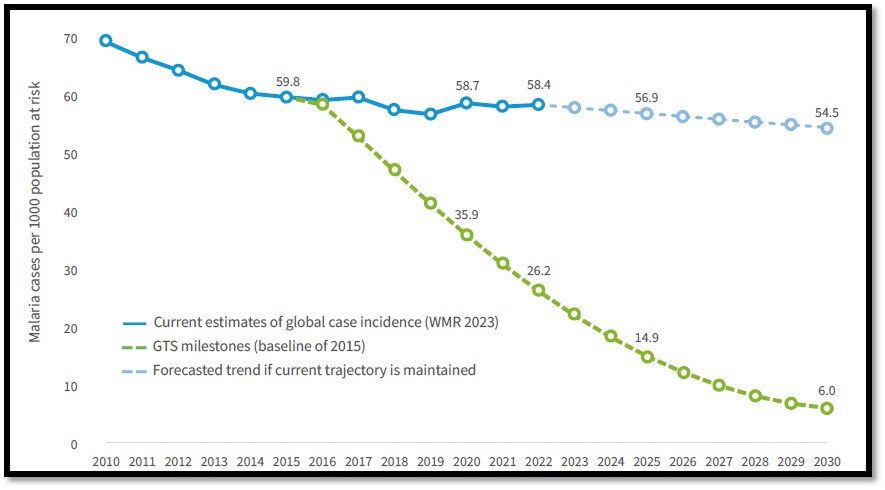
WHO World Malaria Report: Blue solid line=current global malaria cases, Blue dotted line=estimated cases without intervention,
Green solid line=forecast trend of malaria cases with new malaria vaccines
Supply will need to be ramped up to meet the demand
The vaccine was developed by the Jenner Institute at Oxford University who have negotiated a deal with the Serum Institute of India to produce up to 200 million doses annually, so that the R21 vaccine doesn’t face the same manufacturing bottlenecks that many vaccines, including the COVID-19 vaccines, encountered. Vaccinating those at high risk of malaria simultaneously will be important in stemming the spread of disease, as well as protecting the vaccinated.[9]
Technology transfer could mean malaria vaccine production in Ghana
The Serum Institute of India have announced a technology transfer deal to produce the vaccine in Ghana. This can start as soon as a manufacturing facility is completed in Accra[10] and is viewed by many scientists and health workers as critical.
Is the end to malaria in sight?
The WHO Global Malaria Programme goal is to reduce cases of malaria by 90% before 2030.
This will be done by the mass distribution of affordable vaccines as well as the use of insecticide-treated nets and indoor residual spraying. Tens of thousands of genetically modified mosquitoes had been released in Djibouti in an effort to stop the spread of an invasive species that transmits malaria. The "friendly non-biting male Anopheles stephensi mosquitos" were developed by Oxitec, a UK-based biotechnology company and carry a gene that "kills female offspring before they reach maturity."
The WHO remains optimistic that its ambitious objectives can be met, going so far as to classify malaria as being in the "final stage" of elimination. Sir Adrian Hill, director of the Jenner Institute at Oxford said, “I think the whole thing is doable, not in the next five years, but maybe in the next ten," and that for the first time in history, "eradication is beginning to look really credible."[11]
References
WHO: World Malaria Report 2023
Arielle Witter. 6 facts you didn’t know about malaria. 17 August 2022. https://www.one.org/stories/facts-about-malaria/?gad_source=1&gclid=CjwKCAjwzIK1BhAuEiwAHQmU3qLD0KT4Vvnu5fODlSsi9rrnaUKHPgJwmBHwpibpVz6NG116G5FAIhoCnvMQAvD_BwE
Priya Joi. Five things you need to know about the new R21 malaria vaccine. 13 April 2023. https://www.gavi.org/vaccineswork/five-things-you-need-know-about-new-r21-malaria-vaccine?gad_source=1&gclid=CjwKCAjwzIK1BhAuEiwAHQmU3se4pHg5Gj54KJsRKNCTr6hPZmD4z8nl2I7NxxS-xAgV4aTBb8PbShoClJwQAvD_BwE
The Week UK. Have we defeated malaria? 23 July 2024
[1] Key Facts are from the WHO website https://www.who.int/news-room/fact-sheets/detail/malaria
[2] Five things you need to know about the new R21 malaria vaccine
[3] Have we defeated malaria?
[4] Five things you need to know about the new R21 malaria vaccine
[5] Have we defeated malaria?
[6] Have we defeated malaria?
[7] 6 facts you didn’t know about malaria
[8] Five things you need to know about the new R21 malaria vaccine
[9] Ibid
[10] Five things you need to know about the new R21 malaria vaccine
[11] Have we defeated malaria?
